Maternity Lab Exam
5.0(1)
5.0(1)
Card Sorting
1/161
Earn XP
Study Analytics
Name | Mastery | Learn | Test | Matching | Spaced |
|---|
No study sessions yet.
162 Terms
1
New cards
Postpartum period
The interval between the birth of the newborn and the return of reproductive organs to the normal nonpregnant state.
\
Lasts approx. 6 weeks
\
Also called puerperium
\
Lasts approx. 6 weeks
\
Also called puerperium
2
New cards
Involution
the return of the uterus to a nonpregnant state following birth
3
New cards
Subinvolution
failure of the uterus to return to a nonpregnant state
Most common cause is retained placental fragments and infections
Most common cause is retained placental fragments and infections
4
New cards
What strengthens contractions
oxyctocin
5
New cards
Lochia
Uterine discharge after birth
6
New cards

Pad 1
Lochia rubra
* Dark red
* Small clots
* Cramps
* Dark red
* Small clots
* Cramps
7
New cards
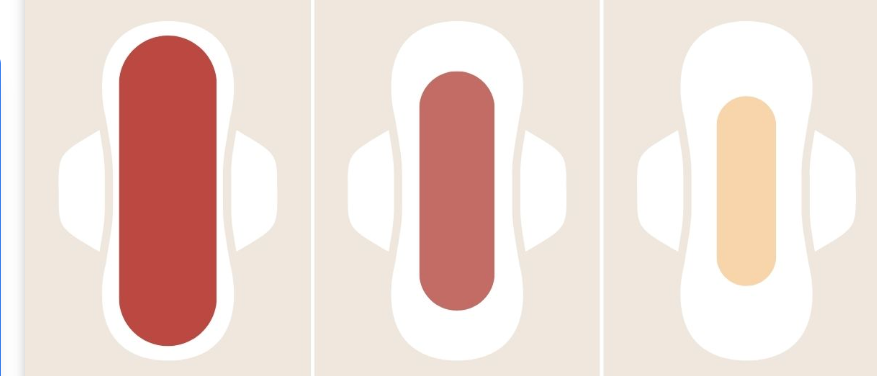
Pad 2
Lochia serosa
* Lasts 4-12 days
* pink/ brown
* Lasts 4-12 days
* pink/ brown
8
New cards

Pad 3
Lochia alba
* Yellow/ white
* Light flow/ spotting
* Lasts from 12 days- 6 weeks
* No clots
* Yellow/ white
* Light flow/ spotting
* Lasts from 12 days- 6 weeks
* No clots
9
New cards
Sara is 20 days postapartum she says she is having period flow style lochia… is this normal?
No period flow lochia lasts about 3-4 days. She should be having light spotting of a white/ yellow discharge (Lochia alba)
This may mean their are retained placenta fragments!!
This may mean their are retained placenta fragments!!
10
New cards
Melissa experinces a gush of fluid when she stands up, what is this??
Lochia tends to pool in the vagina when lying in bed. This is normal
11
New cards
cervix after birth
soft
12
New cards
Dilation of cervix after birth
10 cm during birth
2nd-3rd postpartum day 2-3 cm dilated
by 1 week postpartum 1cm dilated
2nd-3rd postpartum day 2-3 cm dilated
by 1 week postpartum 1cm dilated
13
New cards
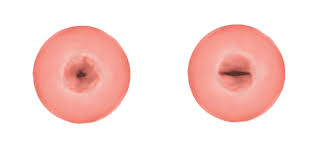
External cervical os
Never regains pre-pregnancy apparence
No longer circle, now a jagged slit (fish mouth)
No longer circle, now a jagged slit (fish mouth)
14
New cards
Rugae of vagina
Reapear after 3 weeks
Not as prominent
Not as prominent
15
New cards
Excerises to help pelvic floor regain tone
kegal exercises
16
New cards
Abdominal wall postpartum
Takes 6 weeks to return
17
New cards
What characteristics are we assessing with lochia?
Smell
Amount
Colour
Clots
Amount
Colour
Clots
18
New cards
Prolactin
Increases in Breastfeeding woman
Responsible for suppressing ovulation
Responsible for suppressing ovulation
19
New cards
What should you teach the new mom about their first menstural period after childbirth
* Heavier than normal
* within 3 or 4 cycles should retrun to normal
* within 3 or 4 cycles should retrun to normal
20
New cards
Profuse diaphoresis
Loss of fluid
at night (usually)
2-3 days after birth
at night (usually)
2-3 days after birth
21
New cards
Simmone is afraid she is not having a bowel movement, what should you tell her?
A bowel movemnet may not occur for 2-3 days postpartum
You may feel discomfort
Drink lots of fluid
You may feel discomfort
Drink lots of fluid
22
New cards
Stepahnie is concerneed about her stretch marks, what can you tell her?
They may fade
23
New cards
When assessing mom’s breasts what are we looking for?
Firmness
Soreness
Cracks
Soreness
Cracks
24
New cards
When assessing the fundus what are we checking for
That it is firm, midline (first 24 hrs at umbilicus) involutes 1-2 cm/ day
25
New cards
What are we assessing for bladder and bowel function
Is she ale to void (within 8 hours of birth)
Bowel movement (by day 3)
Active bowel sounds
Bowel movement (by day 3)
Active bowel sounds
26
New cards
What are we assessing for the moms legs
Any swelling
Edema
Edema
27
New cards
What are we assessing for the perineum or incision
Edema
Episitomy edeges approximated
C/ section dressing clean and dry
Suture line intact
Episitomy edeges approximated
C/ section dressing clean and dry
Suture line intact
28
New cards
What should we assess in rectal area
Any hemorrhoids
29
New cards
What is the acronym for the mom assessment
BUBBLLEE
30
New cards
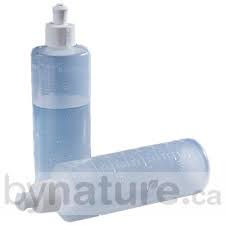
Peri Bottle
Use 3 times a day
Clean perineum area
Warm water
Don’t use every time you go to washroom
Clean perineum area
Warm water
Don’t use every time you go to washroom
31
New cards
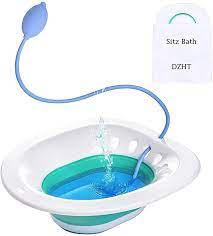
Sitz bath
Water runs in
Helps with epistomtomy
Helps with epistomtomy
32
New cards
What is the ideal time to initate breastfeeding?
1-2 hrs after childbirth
33
New cards
How many calories should a nonlactating woman take in
1800-2200 kcal/day
34
New cards
Benefits of early ambulation
* Decrease chance of blood clotting
35
New cards
When can you bathe the newborn baby
24 hrs after birth
36
New cards
What do you have to check before bathing newborn
Temperature (has to be greater than 36.5)
Axillary (armpit)
Axillary (armpit)
37
New cards
What supplies will you get to prepare for newborn bath?
Comb
Face cloth
Shampoo
Outfit
Diaper
Warm blanket
Towel
Basin
Cotton tip applicator
Face cloth
Shampoo
Outfit
Diaper
Warm blanket
Towel
Basin
Cotton tip applicator
38
New cards
How should we check the temperature of the water (for newborn bath)
wrist
39
New cards
Wash ______ first
face (no soap)
40
New cards
Don’t put soap on babies ________
hands
41
New cards
Blood in babies diaper?
Normal
Pseudomenstruation
Caused by high levels of maternal hormones
Resolves on its own
Pseudomenstruation
Caused by high levels of maternal hormones
Resolves on its own
42
New cards
Meconium
1st bowel movement of baby
Dark, tarry stool
Normal first few days after birth
Dark, tarry stool
Normal first few days after birth
43
New cards
How to wash babies cord
Use wet cotton tip applicator, touch around cord area throw out. Use a dry one and go around cord area.
44
New cards
Safe sleeping position of baby
on back (supine) alone in crib
45
New cards
Thermogensis
* The newborn attempts to generate heat by increasing muscle activity
* Nonshivering
* accomplished primarily by metabolism of brown fat, which is unique to the newborn, and secondarily by increased metabolic activity in the brain, heart, and liver.
* Nonshivering
* accomplished primarily by metabolism of brown fat, which is unique to the newborn, and secondarily by increased metabolic activity in the brain, heart, and liver.
46
New cards
Skin to skin Contact
* Helps control heat loss
* Place the naked healthy baby next to the mother’s skin and cover with a blanket
* Place the naked healthy baby next to the mother’s skin and cover with a blanket
47
New cards
Cold Stress
* Respiratory rate increases
* Basal metabolic rate increases
* Metabolic acidosis
* Respiratory acidosis
* Hypoglycemia (can be asymptomatic in the newborn)
* Basal metabolic rate increases
* Metabolic acidosis
* Respiratory acidosis
* Hypoglycemia (can be asymptomatic in the newborn)
48
New cards
Hyperthermia
* Occurs less frequently than hypothermia
* Must be corrected
* Body temp greater than 37.5
* skin vessels dilate, skin appears flushed, hands and feet are warm to touch, and the infant assumes a posture of extension
* The newborn who is hyperthermic because of sepsis appears stressed: vessels in the skin are constricted, colour is pale, and hands and feet are cool
* Serious overheating of the newborn can cause cerebral damage from dehydration or even heat stroke and death
* Must be corrected
* Body temp greater than 37.5
* skin vessels dilate, skin appears flushed, hands and feet are warm to touch, and the infant assumes a posture of extension
* The newborn who is hyperthermic because of sepsis appears stressed: vessels in the skin are constricted, colour is pale, and hands and feet are cool
* Serious overheating of the newborn can cause cerebral damage from dehydration or even heat stroke and death
49
New cards
Babies HR is 90 beats / min has a good cry is well flexed slight grimacing and has blue extremities. What APGAR scoring would this be?
7
50
New cards
Babies HR is 120 beats/ min and has a weak cry, flaccid muscle tone with slight grimacing and is a pale blue in colour. What APGAR scoring is the baby?
4
51
New cards
Intrauterine growth restriction
when a baby in the womb (a fetus) does not grow as expected
52
New cards
Rooting reflex
Gently stroke corner of babies mouth they should turn their head toward your stroke
53
New cards
Caput succedaneum
Swelling of scalp of newborn
54
New cards
Cephalohematoma
minor condition
pressure on fetal head ruptures small blood vessels when head is compressed against pelvis during labour
pressure on fetal head ruptures small blood vessels when head is compressed against pelvis during labour
55
New cards
Telangiectatic nevi
Flat, pink spots on skin
Stork bites
Stork bites
56
New cards
Acrocycnosis
Blue extremities
57
New cards
Vernix caseosa
White creamy texture covering skin of fetus
58
New cards
Lanugo
Fine soft hair covering newborn fetus
59
New cards
Milia
Bengin cysts
white bumps
white bumps
60
New cards
New Ballard Score
Determines gestational age
61
New cards
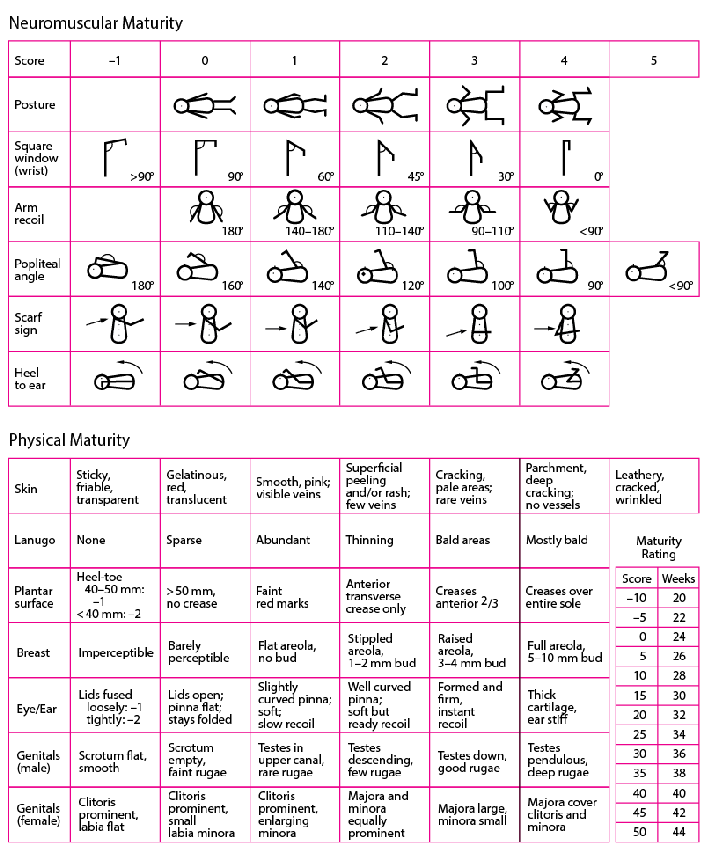
When determining a newborn’s gestional age using the ballard score, what would indicate low neuromusclar maturity?
Arm pulled across midline of chest
62
New cards
What are the 6 physical characteristics assessed to dtermine newborn gestaional age according to the new ballard scale
* Skin
* Lanugo
* Plantar surfaces
* Breast
* Eye/ Ear
* Genitals
* Lanugo
* Plantar surfaces
* Breast
* Eye/ Ear
* Genitals
63
New cards
Cradle cap
Patchy scaling or thick crusts on scalp
64
New cards
SIDS
Sudden Infant Death Syndrome
65
New cards
Erythema toxicum
rash seen in full term newborns
fades within a week
fades within a week
66
New cards
Ophthalmia neonatorum
Bacterial eye infection (from gonorrhea)
67
New cards
How can you prevent opthalmia neonatorum?
Erthroymycin
68
New cards
Moro startle reflex
Startled when they feel like they are falling
Arms go out
Arms go out
69
New cards
Tonic neck reflex
Fencing posture
Turn their head to one side
Turn their head to one side
70
New cards
Palmar grasp reflex
Clench object when pressure and touch is applied to palm
71
New cards
Plantar grasp reflex
Flexion of toes
72
New cards
Babinski sign
Sole of foot firmly stroked
Big toe upward
Other toes fan out
Big toe upward
Other toes fan out
73
New cards
Sucking reflex
Place finger in mouth, baby sucks on it
74
New cards
How long after birth does cord become detached from body?
1-3 weeks
Becomes dry and naturally falls off
Becomes dry and naturally falls off
75
New cards
Vitamin K
IM Injcetion uusally given within 6 hrs of birth
Prevent hemorrhagic disease of newborn
Prevent hemorrhagic disease of newborn
76
New cards
Normal temperature of newborn
Axillary
36\.5-37.5
36\.5-37.5
77
New cards
Respiratory rate of newborn
Count for full minute
30-60 breaths/ min
30-60 breaths/ min
78
New cards
Normal BP of newborn
60-80/ 40-50
79
New cards
Normal weight of newborn
female 3400 g
male 3500 g
male 3500 g
80
New cards
Normal length of baby (top of head to heel)
45-55 cm
81
New cards
Normal head circumference of baby
33-35 cm
82
New cards
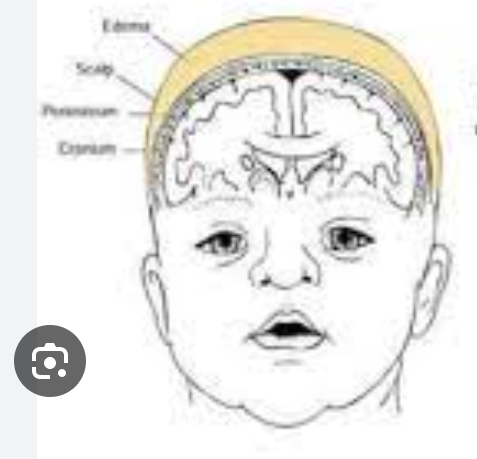
What is this condition?
Caput succedaneum
83
New cards
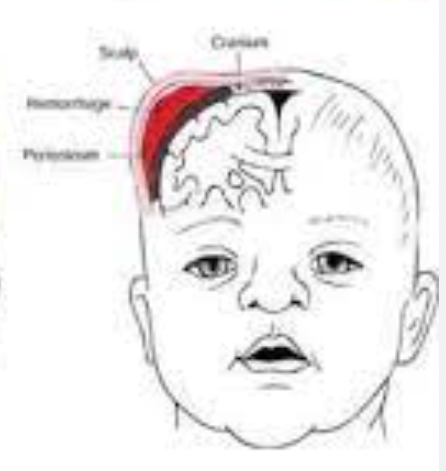
What is this conidtion?
Cephalhematoma
84
New cards
Name 4 benefits of breastfeeding
* Enhances immunity
* Less likely to die from SIDS
* Bonding experince between mom and babe
* Decrease infections
* Less likely to die from SIDS
* Bonding experince between mom and babe
* Decrease infections
85
New cards
List 4 contraindications of breastfeeding
* HIV
* Breast surgery
* Has drugs in system
* Infectious
* Breast surgery
* Has drugs in system
* Infectious
86
New cards
Prolactin
Produces milk
87
New cards
Oxytocin
Resposinble for milk ejection reflex (MER)
88
New cards
How do we know the baby is hungry?
* Hand to mouth motions
* Sucking motions
* Rooting reflex
* Clenched fists
* Sucking motions
* Rooting reflex
* Clenched fists
89
New cards
Late hunger cue
Crying
90
New cards
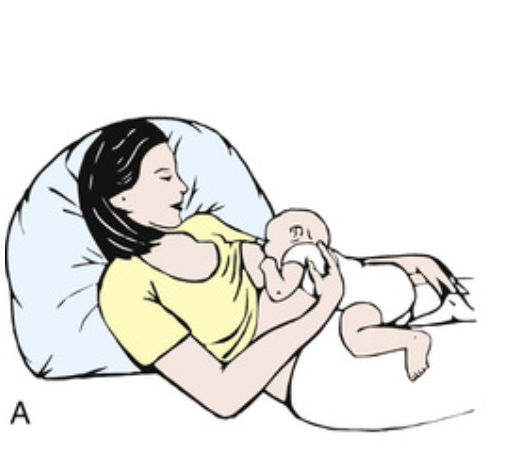
What postion for breastfeeding is this?
Laid back breastfeeding
91
New cards
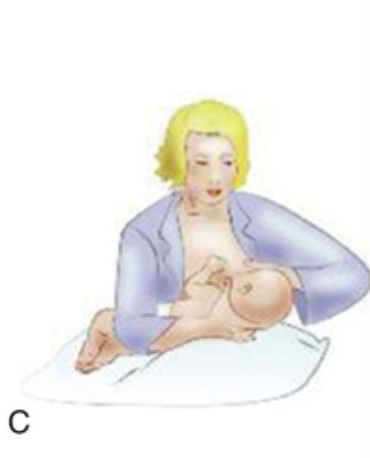
What breastfeeding postion is this?
Cross cradle
92
New cards
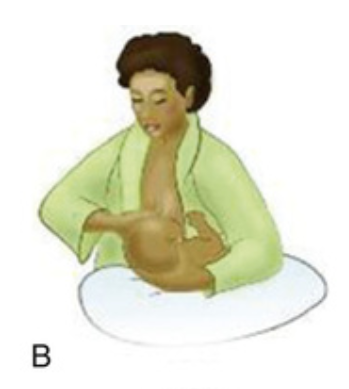
What postion of breastfeeding is this?
Football hold
93
New cards
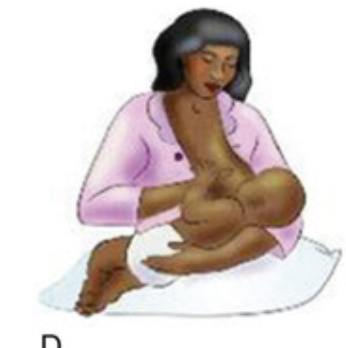
What breastfeeding postion is this?
Cradling
94
New cards

What breastfeeding postion is this?
Side-lying postion
95
New cards
How do we know the feeding is going well?
* Mother feels firm tugging, no pain
* Baby sucks with cheeks rounded
* Audible swallowing
* Baby sucks with cheeks rounded
* Audible swallowing
96
New cards
How often should mom breastfeed?
at least 8-12 times per 24 hrs
97
New cards
Kate states “my baby has been asleep for the past 2 hours I really don’t want to wake her to feed” what do you tell her?
Make sure to awake the baby every 3 hours to feed (DAY)
wake baby every 4 hours to feed (NIGHT)
wake baby every 4 hours to feed (NIGHT)
98
New cards
“How long intervals should I breastfeed for?”
30-40 minutes per breast
99
New cards
Karen says “ I always have coffee in the mornings and I didn’t have any all pregnancy, can I have some now?”
Moderate intake of caffeine by breastfeeding mothers appears to pose no risk to normal full-term infants.
100
New cards
“My breasts feel tender and swollen, is that okay?”
Yes this is common, it lasts about 24 hours
Explore top notes
Explore top flashcards
Maternity Lab Exam
Updated 982d agoMaternity Lab Exam
Updated 982d ago